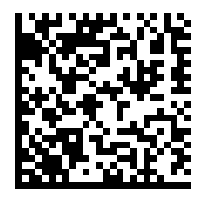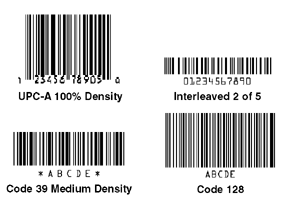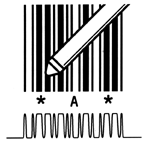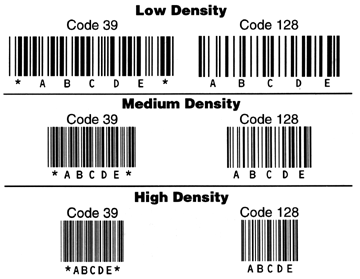
BARCODE
FAQ Pages
Q: What sort of printers can be used to print barcodes?
A: There are four basic types of barcode printing technology: Dot Matrix, Inkjet, Laser, and Thermal (Direct Thermal and Thermal Transfer). Your choice of barcoding printing technology depends upon your application and the materials you will use to create labels.
Different types of barcode label and ribbon materials (i.e. wax, resin, paper, polypropylene, serve different purposes. Whether you need a permanent label designed to weather the elements or a shipping label meant to last three days.
Dot Matrix
Dot matrix print technology is a longstanding method of producing barcodes on-site. The barcode image is produced by hundreds of dots printed in a matrix to make the series of lines and spaces commonly referred to as a barcode.
Advantages:
- Printers are easily accessible and a less expensive option of printing
- Various surfaces can be used to print on
- Multi-pass ribbons can reduce costs for ribbons and label materials
Limitations:
- Barcodes are low to medium density and may not match up to a users standard
- Reusable ribbons can produce illegible barcodes resulting in lower read rates.
- Ink saturation can result in bleeding on the paper resulting in image distortion
- Though many types of material can be printed on, often these labels are not durable, nor can they be water or chemical resistant.
- Printing of single labels results in a great loss of media and is inefficient
- No graphics capability
- Speed is suffered when trying to produce best ink coverage for optimal readability
Ink Jet:
Ink Jet printing is usually used in high production settings where production of barcodes and human readable fonts need to be reproduced at high rates of speed.
Advantages:
- Direct ink jet printing requires only one step to finish the carton or readable material, where other forms may require adhesion of a label to the finished product
- A favourite on high-speed production lines due to its ability to mark "on the fly"
Limitations:
- System installation is very costly as this method is designed for high-volume barcode printing - not for individual or batch printing
- Requires constant supervision to prevent inkjet clogging and maintain proper print quality
- Material use is restricted due to possible bleeding on certain materials
- Printing on dark backgrounds, such as corrugated cardboard, result in hard to read barcodes. Scanning devices must be chosen carefully to ensure proper readability.
Laser:
A laser printer works much like a photo copier. Charging particles of the paper that then attract ions from the ink. These two particles are then bonded together by the heat and pressure of the drum.
Advantages:
- Print high-quality text and graphics on paper documents and can double as a document printer when not being used to print barcodes.
- Density and resolution are relatively high, allowing the production of scannable barcodes at any wavelength when read with an infrared scanner
Limitations:
- Not well suited for industrial environments
- Wasteful in small operations
- Label adhesives must be strong enough to withstand the heat and pressure of the fuser
- Limited durability - cannot produce water resistant nor chemical resistant labels. Toner costs are generally huge with laser printers as they require five times more toner than normal text
Thermal:
Thermal printing includes Direct Thermal and Thermal Transfer, as explained below.
Direct Thermal:
Direct thermal printing is an older technology designed for use with copier and fax machines that utilizes chemically coated paper. It has since been transformed into a highly successful technology for barcoding. The direct thermal print head consists of a long, linear array of tiny resistive heating elements (roughly 100-300/in.) that are arranged perpendicular to the flow of the paper. Each print head element locally heats an area directly below it on the paper. The image is produced by rows of dots caused by chemical reactions that are formed as the media passes beneath the active edge of the print head.
Advantages:
- Produces sharp print quality with great scan-ability
- Ideal for applications with a short-shelf life such as shipping labels and receipts
- Simple to operate and inexpensive to maintain - no ink, toner or ribbon to monitor or replace
- Batch or single label printing is available with minimal waste. Generally Thermal printers are built more durably than dot matrix or laser printers
Limitations:
- Sensitive to environmental conditions such as heat and light
- Paper remains chemically coated after printing, sometimes requiring a coating adhered to the paper to protect from UV light exposure, chemicals and abrasions
Thermal Transfer:
Thermal Transfer printers use the same basic technology as direct thermal printers, but replace chemically coated paper with a non-sensitized face stock and a special, inked ribbon. A durable, polyester ribbon film coated with dry thermal transfer ink is placed between the thermal print head and label. The thermal print head transfers the ink onto the label surface, where it cools and anchors to the media surface. The polyester ribbon is then peeled away, leaving behind a stable, passive image.
Advantages:
- Crisp, high-definition text, graphics, and barcodes for maximum readability and scannability
- Produces long life standability
- Produce batch or single print labels with minimum waste
- Long-term maintenance is low compared to dot-matrix, inkjet, and laser
- Print on a high variety of media stock
- High durability
Limitations:
- Supply costs slightly higher than Direct Thermal as Thermal transfer requires ribbon replacement, though their print head lasts longer
- Ribbon can be wasteful if little is printed from it
- Poor candidate for recycling
- Ribbon and Media MUST be compatible.
Q: What is a barcode:?
A: There is a mystique surrounding bar codes which intimidates many people. Let's eliminate it quickly. First the bar code usually doesn't contain descriptive data, (just like car's license plate number doesn't have anything about your name or where you live). The data in a bar code is just a reference number which the computer uses to look up associated computer disk record(s) which contain descriptive data and other pertinent information.
For example, the bar codes found on food items at a supermarket don't contain the price or description of the food item; instead the bar code has a "product number" (13 digits) in it. When read by a bar code reader and transmitted to the computer, the computer finds the disk file item record(s) associated with that item number. In the disk file is the price, vendor name, quantity on-hand, description, etc. The computer does a "price lookup" by reading the bar code, and then it creates a register of the items and adds the price to the subtotal of the groceries purchased. (It also subtracts the quantity from the "on-hand" total.)
Another example of bar code data might be in a quality reporting application, the bar code may have only a single digit in it, but it may be titled "Failed Vibration Test". The computer associates the single digit with the test result.
So, bar codes typically have only ID data in them; the ID data is used by the computer to look up all the pertinent detailed data associated with the ID data.
Q: What are the different types of Barcode?:
A: There are lots of different bar codes. Some bar codes are numeric only, (i.e. UPC, EAN, GS1 DataBar, ITF Interleaved 2 of 5). Some bar codes are fixed length, (i.e. UPC-A is 12 digits, UPC-E is 6 digits, EAN-13 is 13 digits, EAN-8 is 8 digits, and GS1 DataBar is 14 digits). Some bar codes can have numbers and alphabetic characters, (i.e. Code 93, Code 128, and Code 39). One bar code allows you to encode all 128 characters, (Code 128) while 2D bar codes allow you to encode a lot of data into a small space (PDF417, DataMatrix and Maxicode).
Many were invented some time ago and have been superseded by newer bar codes. Some industries standardized on older bar codes before the better ones had been invented, thus there is a continuing requirement for their use in particular industries.
Many readers have to comply with their customer's or industry's bar coding specifications; no choice is possible, just compliance. Look at the following samples of printed bar codes:




The classic bar code type is Code 39, (also called Code 3 of 9) which has 9 bars and spaces; three are wide, and the other 6 are narrow. In Code 39, 3 of 9 total bars and spaces are wide; hence the name, Code 3 of 9. For example, look at the following character representations with Code 39:

Notice there are two widths of bars and two widths of spaces. If you wished to print a bar code of ABCD, you would need to start and end it with a special Start/Stop code character - the * (asterisk) is used for Code 39. So to print a bar code of ABCD, it would need to be printed as *ABCD*. There should be at least 1/4" of white space to the left and right of the code; this helps the reader pick out where a bar code begins and ends.

GS1 DataBar Stacked
Data Matrix
PDF-417
Other bar code types are similarly constructed. UPC and EAN bar codes have four widths of bars and spaces; so does Code 128.
Q: What Barcode Label & Ribbon should I use:
A: A successful barcode system implementation depends upon barcode labels that stick when they should, come off when necessary, and are readable when scanned. For best results, you need the right combination of barcode printers, barcode label software, label stock, and ribbons for your application.
Contact JRC to discuss your requirements
Ribbon Types
Label printers and barcode printers have three different types of ribbons that can be used. These can be categorized into wax ribbons, wax/resin ribbons, and resin ribbons. Each type of ribbon has their strengths and weaknesses and is dependent on the user's type of application. Below is a description of each type of ribbon.
Ribbon Types:
Wax Ribbons - These ribbons are the lowest cost and are typically used when long term durability is NOT an issue. Thus, wax ribbons are typically used for shipping labels, pricing labels, or other indoor applications. They are best for printing on coated or uncoated paper tags and labels.
Wax/Resin Ribbons - These ribbons have a higher cost than wax ribbons, but are less expensive to resin ribbons. The imprint is more resistant to scratching and smearing and can resist mild chemicals. Since the durability is stronger than wax, but weaker than resin, these ribbons are suitable for short-term outdoor uses and are best for printing on coated paper, coated tags.
Resin Ribbons - These ribbons have the highest cost, but have the highest durability of the three ribbon types. They are mostly used for outdoor applications or if the media requires handling in extreme conditions (continuous physical contact, harsh heat, etc.). They are resistant to most chemicals and are best for printing on synthetics materials such as polyester, polyamide, etc.
Bar Code Structure
A standard 1D bar code is a series of varying width vertical lines (called bars) and spaces. Bars and spaces together are named "elements". There are different combinations of the bars and spaces which represent different characters.
When a bar code scanner is passed over the bar code, the light source from the scanner is absorbed by the dark bars and not reflected, but it is reflected by the light spaces. A photocell detector in the scanner receives the reflected light and converts the light into an electrical signal.
As the wand is passed over the bar code (in the above illustration), the scanner creates a low electrical signal for the spaces (reflected light) and a high electrical signal for the bars (nothing is reflected); the duration of the electrical signal determines wide vs. narrow elements. This signal can be "decoded" by the bar code reader's decoder into the characters that the bar code represents. The decoded data is then passed to the computer in a traditional data format.


Q: Is it is better to invest in a barcode/label printer or to purchase pre-printed bar code labels:
A: On Demand vs. Pre-Printed Labels
Many companies have benefited from ordering pre-printed bar code labels from JRC rather than investing in a barcode/label printer. Pre-printed labels are useful in operations that require only a low volume of identical (i.e., fixed, non-variable data) labels.
However, companies that start with pre-printed labels quickly discover the limitations of this solution option.
Besides restricted flexibility, the use of pre-printed labels prevents companies from including variable customer data or combinations of text and bar code information. As a result, most companies find the financial commitment of printing on-demand bar codes worth the initial investment because of the added value from printing customized information on each label.
For many applications requiring high-volume, mission-critical labels, the added cost of pre-printed labels quickly exceed the cost of the entire system. To the surprise of many barcoding novices, most of the companies that order pre-printed labels also have barcoding printing systems. The pre-printed labels are ordered with the necessary colour, graphics, or standardized text (such as return addresses on shipping labels) and are then fed through a bar code printer to receive customized (i.e., variable) information.
Whether a user elects to use pre-printed or plain labels, media selection is critical to the success of any barcode integration.
Q: What sort of Printer should I use, Direct Thermal or Thermal Transfer Printer
A: Label printers and barcode printers have two different methods of printing known as direct thermal and thermal transfer. There are ups and downs to each one and they are both appropriate for different situations. Here is a description of each printing method.
Direct Thermal
Direct thermal printers use heat from a print head to print directly onto media that has a special chemical coat on it. The image is made when heat is applied to the paper. Direct thermal technology does not need a ribbon. After a while, the images will begin to fade or blacken. Direct thermal technology is ideal for temporary labels, such as shipping labels, but not for items that may be exposed to high temperatures to direct sunlight. Direct thermal printing is an inexpensive way to print labels for temporary applications.
Thermal Transfer
On the other hand, if you need the media to last for a longer than six months, thermal transfer is the correct technology. This technology also uses heat, but instead of a print head applying heat directly to the media, it applies heat to the ribbon which melts the ink from the ribbon onto the media. Thermal transfer is ideal if you are interested in a higher image quality and need the media to last more than six months. The problem of fading or blackened labels is also eliminated with thermal transfer, but supplies for thermal transfer printers must be replenished regularly (i.e. Ribbons).
Q: Can I print my barcode in different colours, or white on a black background?
A: While most of today's barcode scanners have advanced technology, using other colours for barcodes aside from the normal black bar on a white background is highly discouraged. Though they may work when you test them with your scanner, other scanners may not be able to pick up on the different colour variations, especially lower end CCD and laser scanners. It is best to stick with the standard black on white barcode label.
Q: Can I use a laser printer to print out my barcodes?
A: Many people want to save on costs by printing out labels on their existing laser or inkjet printer. While doing this can work, it usually causes a lot of problems.
When you print barcode labels using a laser printer you have to print an entire sheet at a time, so when you only need one label, you still have to run an entire sheet. With a desktop barcode printer, you can print yourself one label, one hundred labels, or one thousand labels with the click of a button. A desktop barcode printer will only save you heartache in the end.
Q: What barcode should I use:?
A: For new bar coding projects that don't have industry or customer standards, Code 39 is the typical non-food standard, because almost all bar code equipment reads/prints Code 39. However, Code 39 produces relatively long bar codes; it is not particularly efficient in bar code density, (the maximum density is 9.4 characters per inch including 2 start/stop characters). Where the label width is an issue and there is numeric data or lower case data, Code 128 is the best alternative; Code 128 also has an extra efficient numeric only packing scheme to produce very dense bar codes, and Code 128 has all 128 ASCII characters. Most readers read Code 128, but before you settle on it as a standard, be sure that your reader is 128 capable .
The larger the width of the elements, the more space it takes to print the bar code; therefore, the lower the bar code density. The thinner the bar and spaces, the less space is required and the higher the bar code density. Look at the samples below of different densities:

Q1: Can we print labels directly from our database?
Q2: Can we print delivery address labels from our database?
A1: When you purchase a TSC printed you receive a "FREE" copy of BarTender "UltraLite". This Bartender version has all the features of the full version BarTender Proffessional or Bartender Enterprise (see Choosing the right BarTender Software ) except that it cannot read from a database. For this feature you need a full version of BarTender available from JRC.
A2: Please see A1: As "Address Labels" only have to last for the time it takes to make the delivery the most economical way to print these labels is to use the "Thermal Direct" method of printing. No ribbon (cost saving) is required, direct themal labels are available from JRC.
Q: Can the TSC Printers be connected to a weighing machine (scales)?
A: Yes, any TTP printers with internal real time clock (like TTP247 + clock chip) can connect to weight machine. BUT a "BASIC" programme must be written. Call JRC for a quotation on the "BASIC" programme and the upgrade price to a suitable TSC printer with a RTC (real time clock)
Web updated July 2015